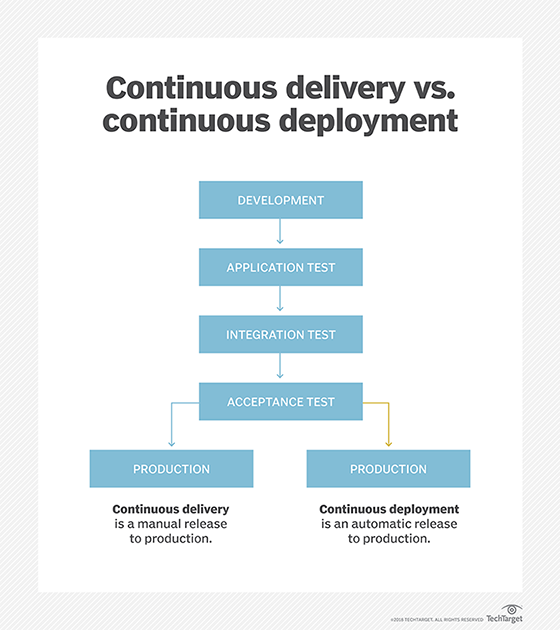What is continuous deployment (CD)? (original) (raw)
By
- Stephen J. Bigelow,
- Kinza Yasar, Technical Writer
Published: Feb 21, 2025
Continuous deployment (CD) is a strategy for software development and releases in which every code change is automatically run through a pipeline of tests and inspections before being pushed into production.
Continuous deployment uses the same fundamental process and workflow as continuous delivery, including design, coding and testing. However, continuous deployment takes the process a step further and applies additional automation and tooling needed to provision and deploy successfully tested software builds to production.
Continuous deployment can limit the human safeguards that prevent unproven code in live software. As a result, it should be incorporated only when the development and IT teams rigorously adhere to well-established, production-ready development practices and thorough testing. They must apply sophisticated, real-time monitoring and metrics in production to discover any issues with new software releases when CD is used. A rollback or recovery process should also be available in the event of unforeseen post-deployment problems, such as unexpected bugs or crashes.
How does continuous deployment work?
The purpose of continuous deployment is to accelerate software development and reduce the time it takes for changes to reach end users.
To apply continuous deployment, a continuous delivery system is typically used to automatically build and test changes to the codebase. Once the changes have passed all tests, they're automatically deployed to a production environment. This can be achieved using well-understood deployment pipelines, which provide automated build, test and deployment processes for updates. The continuous delivery pipeline includes various steps, such as the following:
- Building the code.
- Running automated tests.
- Deploying to staging environments.
- Testing in those environments.
- Deploying to production.
Continuous deployment relies heavily on automation to ensure that changes are deployed quickly, consistently and reliably. By continuously deploying code updates, development teams can discover and correct issues fast, reduce the risk of introducing defects and ultimately deliver value to end users quicker.
Because so much of continuous deployment is automated, it isn't appropriate for all software types; it's most often applied to relatively low-risk applications. Mission-critical apps -- such as medical life-support software where patient well-being is at stake -- typically don't use continuous deployment. They, instead, use continuous delivery models where sensitive builds can be validated and vetted in more controlled environments before being pushed to production.
Benefits of continuous deployment
Continuous deployment offers development teams the following advantages:
- Expedited software delivery. The most significant advantage of continuous deployment and continuous development overall is that it eliminates bottlenecks at each stage of the pipeline, expediting code execution. The code is executed with minimal downtime, letting end users benefit from new features faster, without having to wait weeks or months for a next release cycle to complete.
- Fast feedback. More frequent application upgrades result in a shorter customer feedback loop. With continuous deployment, developers and product managers only need to wait a few minutes to monitor the impact of new changes on user behavior or engagement and modify accordingly. When client behavior indicates the need for a quick change in approach, continuous deployment provides the ability to release updates fast. CD also aids in detecting issues and shortens the feedback loop for user-facing modifications.
- Reduced development risks. Continuous deployment decreases development risks. When teams integrate consistently and frequently, they reduce potential risks because they always know the system's current status. This high level of familiarity has the potential to enhance overall software quality.
- Fewer manual processes. Continuous deployment encourages engineers to automate as much of the software development and code deployment and release process as possible, including release testing, resource provisioning, instrumentation to collect data and actual deployment, such as moving a build to a provisioned virtual machine. Automation lets developers push new releases more quickly and save time normally spent on manual approvals and processes.
- Optimized collaboration. CD encourages teams to provide regular input so the product can be enhanced and improved through iteration.
- Fail faster. Continuous development facilitates the discovery and resolution of bugs in alignment with agile development paradigms that embrace iteration and ongoing improvement. Spending time trying to identify more bugs before pushing out a new iteration isn't always the best approach. Getting the newest iteration to users is often the best way to discover and address defects.
Continuous deployment vs. continuous delivery
Continuous integration, delivery and deployment are collectively referred to as continuous software development that's associated with the Agile and DevOps methodologies. Continuous delivery and deployment originated from continuous integration, a method to develop, build and test new software code rapidly using test automation processes. These processes ensure only code that's known to be good becomes part of a software product.
Continuous deployment isn't the same as continuous delivery, although the two terms are often confused.

Although the two terms are often confused, continuous delivery and continuous deployment differ in how code changes are released to production.
Continuous delivery occurs when developers frequently hand off new code to the quality assurance and operations teams for testing. It involves a production-like staging area, and there's often a time lag between a release and when it's reviewed, when changes are manually accepted and when the new code is released to production.
In contrast, continuous deployment doesn't require a staging area for code changes to be manually reviewed and verified, though staging can remain an integral part of the routine testing environment. Automated testing is integrated early in the development process and continues throughout all release phases. One of the main benefits of continuous deployment is that there's no time lag between when a code change passes application- and platform-level testing and when it moves into production.
Both continuous delivery and continuous deployment rely on real-time infrastructure provisioning and application monitoring tools to discover any problems that weren't caught in the testing feedback loops before deployment. Testing and monitoring are more important in the continuous deployment process because there's no human intervention for performance verification.
Regulatory compliance or other restrictions, such as business governance, can prevent an IT organization from adopting continuous deployment. Other considerations, such as the maturity of DevOps processes and best practices within the IT organization, should also influence the decision of whether to deploy code on a continuous delivery or continuous deployment basis or some combination of the two approaches based on the application's lifecycle and the users.
Continuous deployment pipelines use tools like those used in continuous delivery, with an enhanced emphasis on code testing prior to and after deployment into production. The following are some tools in a continuous deployment workflow:
- Continuous integration tools. CI is a crucial feature of continuous deployment that reduces development bottlenecks when several developers work on the same project. Common tools to automate the building, testing and deployment of code changes include Amazon Web Services' (AWS's) CodeBuild, Atlassian's Bamboo, CircleCI, the open source tool Jenkins, Microsoft's Azure DevOps Server and Travis CI.
- Version control systems. Version control, also referred to as revision or source control, facilitates team collaboration regardless of where and when people work by increasing the visibility of a project's updates and changes. Version control systems, such as AWS's CodeCommit, Azure DevOps, Apache Subversion, Git and Mercurial, are critical for continuous deployment, letting users track new versions and manage code changes.
- Configuration management tools. Configuration management is the process of ensuring all software and hardware remain in a consistent state. This can include proper configuration and automation of all servers, networking, storage and software. Tools such as CFEngine, IBM's Ansible, Perforce's Puppet, Progress Software's Chef, Rudder and Salt Project support configuration and management of infrastructure and applications.
- Monitoring and observability tools. Monitoring and incident response for continuous deployment setups should be as close to real time as possible to shorten the time to recovery when there are problems in the code. Tools such as Cisco's Splunk AppDynamics, Datadog, Dynatrace, Elastic Observability, Grafana Labs' Grafana, New Relic and Prometheus fulfill these needs.
- Containerization and orchestration tools. Some applications can be deployed in containers to isolate updates from the underlying infrastructure. Containerization tools such as Amazon Elastic Container Service, Apache Mesos, Docker, Google Kubernetes Engine, Kubernetes and Red Hat's OpenShift package applications and dependencies in a portable format, making scaling and deployment easier.
- Deployment automation tools. Tools such as AWS CodeDeploy, Azure DevOps, GitLab, Google Cloud Build and Octopus Deploy are useful for automating the deployment of code changes to production environments,
Rollback functionality is necessary in any deployment tool set so any unexpected or undesired effects of new code in production can be caught and fixed quickly. Organizations can rely on canary deployment, sharding, blue/green deployment, feature flags or toggles, and other deployment controls to guard against user disruption from continuous deployment.
When deciding to implement a continuous integration/continuous delivery (CI/CD) pipeline, there are many factors to consider. Discover the stages involved in a CI/CD pipeline, the advantages and difficulties, and recommended approaches.
Continue Reading About What is continuous deployment (CD)?
- Continuous delivery vs. continuous deployment: Which to choose
- Testing tools for continuous deployment
- How to weigh the benefits and challenges of CI/CD
- Best practices for configuration file management
- Best practices for automated end-to-end testing
 Continuous delivery vs. continuous deployment: Which to choose?
Continuous delivery vs. continuous deployment: Which to choose?  By: Matt Heusser
By: Matt Heusser  CI/CD pipelines explained: Everything you need to know
CI/CD pipelines explained: Everything you need to know  By: Stephen Bigelow
By: Stephen Bigelow  How to put CI, CT and CD together in a DevOps pipeline
How to put CI, CT and CD together in a DevOps pipeline  By: Michael Levan
By: Michael Levan  What is continuous integration (CI)?
What is continuous integration (CI)?